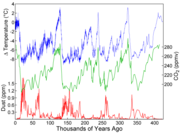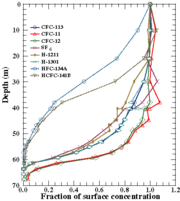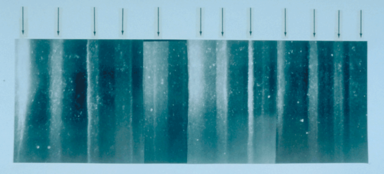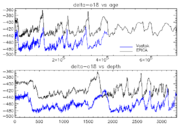Ice core
2008/9 Schools Wikipedia Selection. Related subjects: Climate and the Weather
An ice core is a core sample from the accumulation of snow and ice over many years that have re-crystallized and have trapped air bubbles from previous time periods. The composition of these ice cores, especially the presence of hydrogen and oxygen isotopes, provides a picture of the climate at the time.
Because water molecules containing heavier isotopes exhibit a lower vapor pressure, when the temperature falls, the heavier water molecules will condense faster than the normal water molecules. The relative concentrations of the heavier isotopes in the condensate indicate the temperature of condensation at the time, allowing for ice cores to be used in local temperature reconstruction after certain assumptions. In addition to the isotope concentration, the air bubbles trapped in the ice cores allow for measurement of the atmospheric concentrations of trace gases, including greenhouse gases carbon dioxide, methane, and nitrous oxide.
Ice cores contain an abundance of climate information. Inclusions in the snow of each year remain in the ice, such as wind-blown dust, ash, bubbles of atmospheric gas and radioactive substances. The variety of climatic proxies is greater than in any other natural recorder of climate, such as tree rings or sediment layers. These include ( proxies for) temperature, ocean volume, precipitation, chemistry and gas composition of the lower atmosphere, volcanic eruptions, solar variability, sea-surface productivity, desert extent and forest fires.
Typical ice cores are removed from an ice sheet, most commonly from the polar ice caps of Antarctica, Greenland or from high mountain glaciers elsewhere. As the ice forms from the incremental buildup of annual layers of snow, lower layers are older than upper, and an ice core contains ice formed over a range of years. The properties of the ice or inclusions within the ice can then be used to reconstruct a climatic record over the age range of the core.
The length of the record depends on the depth of the ice core and varies from a few years up to 800 kyr for the EPICA core. The time resolution (i.e. the shortest time period which can be accurately distinguished) depends on the amount of annual snowfall, and reduces with depth as the ice compacts under the weight of layers accumulating on top of it. Upper layers of ice in a core correspond to a single year or sometimes a single season. Deeper into the ice the layers thin and annual layers become indistinguishable.
An ice core from the right site can be used to reconstruct an uninterrupted and detailed climate record extending over hundreds of thousands of years, providing information on a wide variety of aspects of climate at each point in time. It is the simultaneity of these properties recorded in the ice that makes ice cores such a powerful tool in paleoclimate research.
Structure of ice sheets and cores
Most ice sheets are formed from snow. Because an ice sheet survives summer, the temperature in that location usually does not warm much above freezing. In many locations in Antarctica the air temperature is always well below the freezing point of water. If the summer temperatures do get above freezing, any ice core record will be severely degraded or completely useless, since meltwater will percolate into the snow.
The surface layer is snow in various forms, with air gaps between snowflakes. As snow continues to accumulate, the buried snow is compressed and forms firn, a grainy material with a texture similar to granulated sugar. Air gaps remain, and some circulation of air continues. As snow accumulates above, the firn continues to densify, and at some point the pores close off and the air is trapped. Because the air continues to circulate until then, the ice age and the age of the gas enclosed are not the same, and may differ by hundreds of years. The gas age–ice age difference is as great as 7 kyr in glacial ice from Vostok.
Under increasing pressure, at some depth the firn is compressed into ice. This depth may range between a few to several tens of meters to typically 100 m for Antarctic cores. Below this level material is frozen in the ice. Ice may appear clear or blue.
Layers can be visually distinguished in firn and in ice to significant depths. In a location on the summit of an ice sheet where there is little flow, accumulation tends to move down and away, creating layers with minimal disturbance. In a location where underlying ice is flowing, deeper layers may have increasingly different characteristics and distortion. Drill cores near bedrock often are challenging to analyze due to distorted flow patterns and composition likely to include materials from the underlying surface.
Characteristics of firn
The layer of porous firn on Antarctic ice sheets is 50-150 m deep. It is much less deep on glaciers.
Air in the atmosphere and firn are slowly exchanged by molecular diffusion through pore spaces, because gases move toward regions of lower concentration. Thermal diffusion causes isotope fractionation in firn when there is rapid temperature variation, creating isotope differences which are captured in bubbles when ice is created at the base of firn. There is gas movement due to diffusion in firn, but not convection except very near the surface.
Below the firn is a zone in which seasonal layers alternately have open and closed porosity. These layers are sealed with respect to diffusion. Gas ages increase rapidly with depth in these layers. Various gases are fractionated while bubbles are trapped where firn is converted to ice.
Coring
A core is collected by separating it from the surrounding material. For material which is sufficiently soft, coring may be done with a hollow tube. Deep core drilling into hard ice, and perhaps underlying bedrock, involves using a hollow drill which actively cuts a cylindrical pathway downward around the core.
When a drill is used, the cutting apparatus is on the bottom end of a drill barrel, the tube which surrounds the core as the drill cuts downward around the edge of the cylindrical core. The length of the drill barrel determines the maximum length of a core sample (6 m at GISP2 and Vostok). Collection of a long core record thus requires many cycles of lowering a drill/barrel assembly, cutting a core 4-6 m in length, raising the assembly to the surface, emptying the core barrel, and preparing a drill/barrel for drilling.
Because deep ice is under pressure and can deform, for cores deeper than about 300 m the hole will tend to close if there is nothing to supply back pressure. The hole is filled with a fluid to keep the hole from closing. The fluid, or mixture of fluids, must simultaneously satisfy criteria for density, low viscosity, frost resistance, as well as workplace safety and environmental compliance. The fluid must also satisfy other criteria, for example those stemming from the analytical methods employed on the ice core. A number of different fluids and fluid combinations have been tried in the past. Since GISP2 (1990-1993) the US Polar Program has utilized a single-component fluid system, n-butyl acetate, but the toxicology, flammability, aggressive solvent nature, and longterm liabilities of n-butyl acetate raises serious questions about its continued application. The European community, including the Russian program, has concentrated on the use of two-component drilling fluid consisting of low-density hydrocarbon base (brown kerosene was used at Vostok) boosted to the density of ice by addition of halogenated-hydrocarbon densifier. Many of the proven densifier products are now considered too toxic, or are no longer available due to efforts to enforce the Montreal Protocol on ozone-depleting substances. In April 1998 on the Devon Ice Cap filtered lamp oil was used as a drilling fluid. In the Devon core it was observed that below about 150 m the stratigraphy was obscured by microfractures.
Core processing
Modern practice is to ensure that cores remain uncontaminated, since they are analysed for trace quantities of chemicals and isotopes. They are sealed in plastic bags after drilling and analysed in clean rooms.
The core is carefully extruded from the barrel; often facilities are designed to accommodate the entire length of the core on a horizontal surface. Drilling fluid will be cleaned off before the core is cut into 1-2 meter sections. Various measurements may be taken during preliminary core processing.
Current practices to avoid contamination of ice include:
- Keeping ice well below the freezing point.
- At Greenland and Antarctic sites, temperature is maintained by having storage and work areas under the snow/ice surface.
- At GISP2, cores were never allowed to rise above -15 °C, partly to prevent microcracks from forming and allowing present-day air to contaminate the fossil air trapped in the ice fabric, and partly to inhibit recrystallization of the ice structure.
- Wearing special clean suits over cold weather clothing.
- Mittens or gloves.
- Filtered respirators.
- Plastic bags, often polyethylene, around ice cores. Some drill barrels include a liner.
- Proper cleaning of tools and laboratory equipment.
- Use of laminar-flow bench to isolate core from room particulates.
For shipping, cores are packed in Styrofoam boxes protected by shock absorbing bubble-wrap.
Due to the many types of analysis done on core samples, sections of the core are scheduled for specific uses. After the core is ready for further analysis, each section is cut as required for tests. Some testing is done on site, other study will be done later, and a significant fraction of each core segment is reserved for archival storage for future needs.
Projects have used different core-processing strategies. Some projects have only done studies of physical properties in the field, while others have done significantly more study in the field. These differences are reflected in the core processing facilities.
Ice relaxation
Deep ice is under great pressure. When brought to the surface, there is a drastic change in pressure. Due to the internal pressure and varying composition, particularly bubbles, sometimes cores are very brittle and can break or shatter during handling. At Dome C, the first 1000 m were brittle ice. Siple dome encountered it from 400 to 1000 m. It has been found that allowing ice cores to rest for some time (sometimes for a year) makes them become much less brittle.
Decompression causes significant volume expansion (called relaxation) due to microcracking and the exsolving of enclathratized gases. Relaxation may last for months. During this time, ice cores are stored below -10 °C to prevent cracking due to expansion at higher temperatures. At drilling sites, a relaxation area is often built within existing ice at a depth which allows ice core storage at temperatures below -20 °C.
It has been observed that the internal structure of ice undergoes distinct changes during relaxation. Changes include much more pronounced cloudy bands and much higher density of "white patches" and bubbles.
Several techniques have been examined. Cores obtained by hot water drilling at Siple Dome in 1997-1998 underwent appreciably more relaxation than cores obtained with the PICO electro-mechanical drill. In addition, the fact that cores were allowed to remain at the surface at elevated temperature for several days likely promoted the onset of rapid relaxation.
Ice core data
Many materials can appear in an ice core. Layers can be measured in several ways to identify changes in composition. Small meteorites may be embedded in the ice. Volcanic eruptions leave identifiable ash layers. Dust in the core can be linked to increased desert area or wind speed.
Isotopic analysis of the ice in the core can be linked to temperature and global sea level variations. Analysis of the air contained in bubbles in the ice can reveal the palaeocomposition of the atmosphere, in particular CO2 variations. There are great problems relating the dating of the included bubbles to the dating of the ice, since the bubbles only slowly "close off" after the ice has been deposited. Nonetheless, recent work has tended to show that during deglaciations CO2 increases lags temperature increases by 600 +/- 400 years . Beryllium 10 concentrations are linked to cosmic ray intensity which can be a proxy for solar strength (see proxy).
There may be an association between atmospheric nitrates in ice and solar activity. However, recently it was discovered that sunlight triggers chemical changes within top levels of firn which significantly alter the pore air composition. This raises levels of formaldehyde and NOx. Although the remaining levels of nitrates may indeed be indicators of solar activity, there is ongoing investigation of resulting and related effects of effects upon ice core data.
Core contamination
Some contamination has been detected in ice cores. The levels of lead on the outside of ice cores is much higher than on the inside. In ice from the Vostok core (Antarctica), the outer portion of the cores have up to 3 and 2 orders of magnitude higher bacterial density and dissolved organic carbon than the inner portion of the cores, respectively, as a result of drilling and handling.
Paleoatmospheric sampling
As porous snow consolidates into ice, the air within it is trapped in bubbles in the ice. This process continuously preserves samples of the atmosphere. In order to retrieve these natural samples the ice is ground at low temperatures, allowing the trapped air to escape. It is then condensed for analysis by gas chromatography or mass spectrometry, revealing gas concentrations and their isotopic composition respectively. Apart from the intrinsic importance of knowing relative gas concentrations (e.g. to estimate the extent of greenhouse warming), their isotopic composition can provide information on the sources of gases. For example CO2 from fossil-fuel or biomass burning is relatively depleted in 13C. See Friedli et al., 1986.
Dating the air with respect to the ice it is trapped in is problematic. The consolidation of snow to ice necessary to trap the air takes place at depth (the 'trapping depth') once the pressure of overlying snow is great enough. Since air can freely diffuse from the overlying atmosphere throughout the upper unconsolidated layer (the 'firn'), trapped air is younger than the ice surrounding it.
Trapping depth varies with climatic conditions, so the air-ice age difference could vary between 2500 and 6000 years (Barnola et al., 1991). However, air from the overlying atmosphere may not mix uniformly throughout the firn (Battle et al., 1986) as earlier assumed, meaning estimates of the air-ice age difference could be less than imagined. Either way, this age difference is a critical uncertainty in dating ice-core air samples. In addition, gas movement would be different for various gases; for example, larger molecules would be unable to move at a different depth than smaller molecules so the ages of gases at a certain depth may be different. Some gases also have characteristics which affect their inclusion, such as helium not being trapped because it is soluble in ice.
In Law Dome ice cores, the trapping depth at DE08 was found to be 72 m where the age of the ice is 40±1 years; at DE08-2 to be 72 m depth and 40 years; and at DSS to be 66 m depth and 68 years.
Paleoatmospheric firn studies
At the South Pole, the firn-ice transition depth is at 122 m, with a CO2 age of about 100 years. Gases involved in ozone depletion, CFCs, chlorocarbons, and bromocarbons, were measured in firn and levels were almost zero at around 1880 except for CH3Br, which is known to have natural sources. Similar study of Greenland firn found that CFCs vanished at a depth of 69 m (CO2 age of 1929).
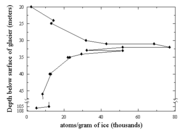
Analysis of the Upper Fremont Glacier ice core showed large levels of chlorine-36 that definitely correspond to the production of that isotope during atmospheric testing of nuclear weapons. This result is interesting because the signal exists despite being on a glacier and undergoing the effects of thawing, refreezing, and associated meltwater percolation. 36Cl has also been detected in the Dye-3 ice core (Greenland), and in firn at Vostok.
Studies of gases in firn often involve estimates of changes in gases due to physical processes such as diffusion. However, it has been noted that there also are populations of bacteria in surface snow and firn at the South Pole, although this study has been challenged. It had previously been pointed out that anomalies in some trace gases may be explained as due to accumulation of in-situ metabolic trace gas byproducts.
Dating cores
Shallow cores, or the upper parts of cores in high-accumulation areas, can be dated exactly by counting individual layers, each representing a year. These layers may be visible, related to the nature of the ice; or they may be chemical, related to differential transport in different seasons; or they may be isotopic, reflecting the annual temperature signal (for example, snow from colder periods has less of the heavier isotopes of H and O). Deeper into the core the layers thin out due to ice flow and eventually individual years cannot be distinguished. It may be possible to identify events such as nuclear bomb atmospheric testing's radioisotope layers in the upper levels, and ash layers corresponding to known volcanic eruptions. Volcanic eruptions may be detected by visible ash layers, acidic chemistry, or electrical resistance change. Some composition changes are detected by high-resolution scans of electrical resistance. Lower down the ages are reconstructed by modeling accumulation rate variations and ice flow.
Dating is a difficult task. Five different dating methods have been used for Vostok cores, with differences such as 300 years at 100 m depth, 600yr at 200 m, 7000yr at 400 m, 5000yr at 800 m, 6000yr at 1600 m, and 5000yr at 1934 m.
Different dating methods makes comparison and interpretation difficult. Matching peaks by visual examination of Moulton and Vostok ice cores suggests a time difference of about 10,000 years but proper interpretation requires knowing the reasons for the differences.
Ice core sites
Ice cores have been taken from many locations around the world. Major efforts have taken place on Greenland and Antarctica.
Sites on Greenland are more susceptible to snow melt than those in Antarctica. In the Antarctic, areas around the Antarctic Peninsula and seas to the west have been found to be affected by ENSO effects. Both of these characteristics have been used to study such variations over long spans of time.
Greenland
Dye 3
GRIP/GISP
The GRIP and GISP cores, each about 3000 m long, were drilled by European and US teams respectively on the summit of Greenland. Their usable record stretches back more than 100,000 years into the last interglacial. They agree (in the climatic history recovered) to a few metres above bedrock. However, the lowest portion of these cores cannot be interpreted, probably due to disturbed flow close to the bedrock. There is evidence the GISP2 cores contain an increasing structural disturbance which casts suspicion on features lasting centuries or more in the bottom 10% of the ice sheet. The more recent NorthGRIP ice core provides a undisturbed record to approx. 123,000 years before present. The results indicate that Holocene climate has been remarkably stable and have confirmed the occurrence of rapid climatic variation during the last ice age.
NGRIP
The NGRIP drilling site is near the centre of Greenland (, 2917 m, ice thickness 3085). Drilling began in 1999 and was completed at bedrock in 2003. The NGRIP site was chosen to extract a long and undisturbed record stretching into the last glacial. NGRIP covers 5 kyr of the Eemian, and shows that temperatures then were roughly as stable as the pre-industrial Holocene temperatures were.
Antarctica
Vostok
Up to 2003, the longest core drilled was at Vostok station. It reached back 420,000 years and revealed 4 past glacial cycles. Drilling stopped just above Lake Vostok. The Vostok core was not drilled at a summit, hence ice from deeper down has flowed from upslope; this slightly complicates dating and interpretation. Vostok core data is available.
EPICA/Dome C
The EPICA core in Antarctica was drilled at (560 km from Vostok) at an altitude of 3,233 m, near Dome C. The ice thickness is 3,309 +/-22 m and the core was drilled to 3,190 m. Present-day annual average air temperature is -54.5 °C and snow accumulation 25 mm/y. Information about the core was first published in Nature on June 10, 2004. The core went back 720,000 years and revealed 8 previous glacial cycles.
Dome F
Two deep ice cores were drilled near the Dome F summit (, altitude 3,810 m). The first drilling started in August 1995, reached a depth of 2503 m in December 1996 and covers a period back to 320,000 years. The second drilling started in 2003, was carried out during four subsequent austral summers from 2003/2004 until 2006/2007, and by then a depth of 3,035.22 m was reached. This core greatly extends the climatic record of the first core, and, according to a first, preliminary dating, it reaches back until 720,000 years.
WAIS Divide
The West Antarctice Ice Sheet Divide ( WAIS Divide) Ice Core Drilling Project began drilling over the 2005 and 2006 seasons, drilling ice cores up to the depth of 300 m for the purposes of gas collection, other chemical applications, and to test the site for use with the Deep Ice Sheet Coring (DISC) Drill. Sampling with the DISC Drill will begin over the 2007 season and researchers and scientists expect that these new ice cores will provide data to establish a greenhouse gas record back over 40,000 years.
Non-polar cores
The non-polar ice caps, such as found on mountain tops, were traditionally ignored as serious places to drill ice cores because it was generally believed the ice would not be more than a few thousand years old, however since the 1970s ice has been found that is older, with clear chronological dating and climate signals going as far back as the beginning of the most recent ice age. Although polar cores have the clearest and longest chronological record, four-times or more as long, ice cores from tropical regions offer data and insights not available from polar cores and have been very influential in advancing understanding of the planets climate history and mechanisms.
Mountain ice cores have been retrieved in the Andes in South America, Mount Kilimanjaro in Africa, Tibet, various locations in the Himalayas, Alaska, Russia and elsewhere. Mountain ice cores are logistically very difficult to obtain. The drilling equipment must be carried by hand, organized as a mountaineering expedition with multiple stage camps, to altitudes upwards of 20,000 feet (helicopters are not safe), and the multi-ton ice cores must then be transported back down the mountain, all requiring mountaineering skills and equipment and logistics and working at low oxygen in extreme environments in remote third world countries. Scientists may stay at high altitude on the ice caps for up 20 to 50 days setting altitude endurance records that even professional climbers do not obtain. American scientist Lonnie Thompson has been pioneering this area since the 1970s, developing light-weight drilling equipment that can be carried by porters, solar-powered electricity, and a team of mountaineering-scientists. The ice core drilled in Guliya ice cap in western China in the 1990s reaches back to 760,000 years before the present — farther back than any other core at the time, though the EPICA core in Antarctica equalled that extreme in 2003.
Because glaciers are retreating rapidly world-wide, some important glaciers are now no longer scientifically viable for taking cores, and many more glacier sites will continue to be lost, the "Snows of Mount Kilimanjaro" (Hemingway) for example could be gone by 2015.




